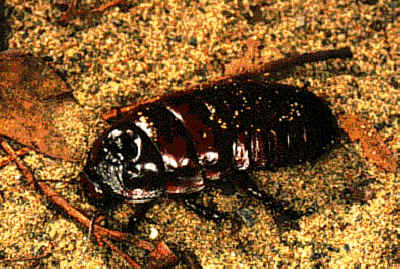




 |
Order
- BLATTODEA
(Greek, blatta = an insect that shuns light)
Common Name: cockroaches
Distribution: Cosmopolitan, predominantly
tropical
Description
There are thousands of species of cockroaches worldwide, but only about
ten are household pests. All species have a flattened body with the head
attached and constructed in such a way that the mandibles open vertically
downwards. The compound eyes are generally well developed, but they may be
absent in cave dwelling species. Simple eyes (ocelli) if present are
represented by two pale spots. Cockroaches have filiform antennae
(composed of short, straight segments) and the legs are often spiny. Body
colour is generally reddish-brown, brown or black. Wings may or may not be
present - many Australian native species of cockroach are wingless. When
present, the forewings are often partially hardened into protective covers
(tegmina) to prevent damage to the hind wings which are used for flying.
Nymph
There is no metamorphic cycle of egg-larva-pupa-adult in these insects. The
juveniles emerge from the eggs as wingless replicas of the adults (nymphs) and
grow by successive moults until they reach mature size.
Members
Cockroaches.
Food
Cockroaches are essentially scavengers. The "domestic" species have
been known to consume white-wash, books, boots, hair, skin, finger nails, ink,
their own egg cases and any material that has food value. The Australian wood
cockroaches eat plant debris while other species consume wood by employing
flagellate protozoans to digest the cellulose in the same manner as termites.
Importance
To human economics, harm from cockroaches is not so much created by the
amount of food consumed by the insects, but rather by the spoilage created
through their activities. Faeces are left on any area where they have been
feeding and their habit of first softening their meal by covering it with both
digestive tract enzymes and stomach contents leaves extremely unpleasant odours
behind. They are also well known as disease carriers. Australian wood
cockroaches appear to be important in the food chains of arachnids such as
spiders. Empty husks of numbers of cockroaches are sometimes found in the
web/nest areas of spiders.